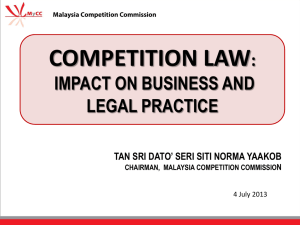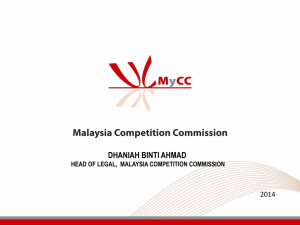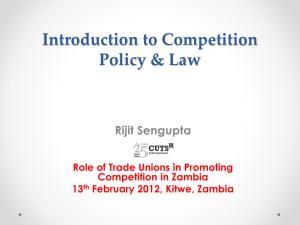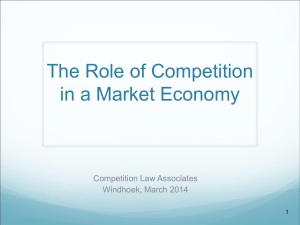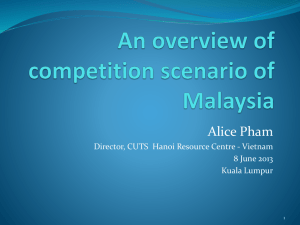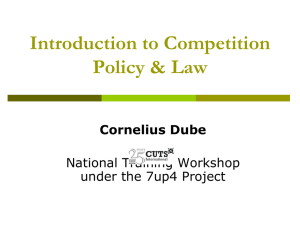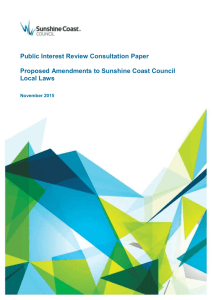Role of Media
advertisement
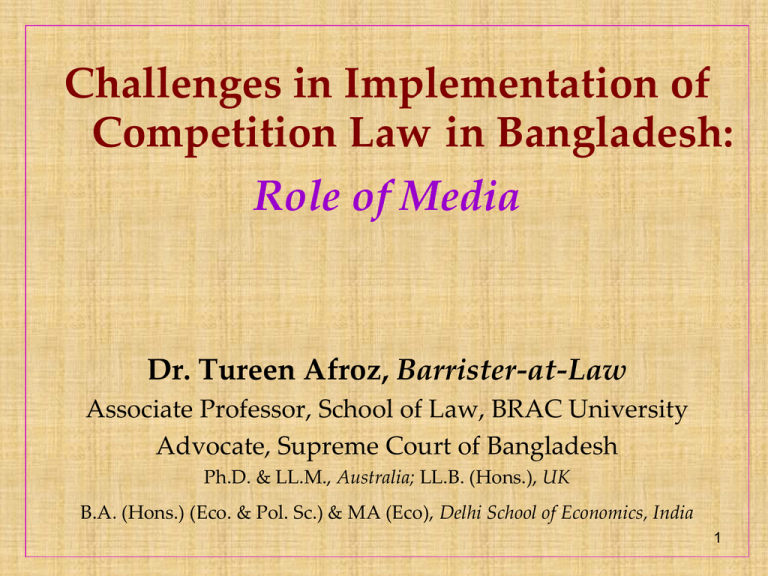
Challenges in Implementation of Competition Law in Bangladesh: Role of Media Dr. Tureen Afroz, Barrister-at-Law Associate Professor, School of Law, BRAC University Advocate, Supreme Court of Bangladesh Ph.D. & LL.M., Australia; LL.B. (Hons.), UK B.A. (Hons.) (Eco. & Pol. Sc.) & MA (Eco), Delhi School of Economics, India 1 OVERVIEW OF COMPETITION REGULATION 2 WHY REGULATION? •Externalities (private cost < social cost) •Public goods (free rider problem) •Information asymmetry (lemons market) •Market failure (systemic risk) •Equitable justice (production & distribution) •Consumer welfare (growth vs. development, poverty etc.) 3 REGULATING COMPETITION •Competition Policy •Competition Law 4 COMPETITION POLICY 5 DEFINITION OF COMPETITION POLICY • Competition Policy refers to a set of government measures that enhance competition or competitive outcomes in the markets. •It includes both economic policies that enhance competition and competition laws. Competition Policy = f (ecoc policy, compn law) 6 RELEVANT ECONOMIC POLICIES •International trade policy •Industrial policy •Privatization reform policy •Labor policy •Exchange rate policy •Fiscal policy •Monetary policy •Regulatory reform policy •Intellectual property rights policy 7 COMPETITION LAW 8 COMPETITION LAW The most ancient example of competition law is the Lex Julia de Annona of Rome in around 50BC. But in today’s world we have• United States: the Sherman Act, 1890 • United Kingdom: the Monopolies and Restrictive Practices (Inquiry and Control) Act, 1948 • European Union: the Treaty of Rome, 1957 • Germany: the Act Against Unfair Restraints of Competition, 1957 • Japan: the Act Concerning Prohibition of Private Monopoly and Maintenance of Fair Trade, 1947 9 COMPETITION LAW CONTD. •Since the beginning of the 1990s, the number of systems of competition law has proliferated. •Competition law is now in place in all six continents, and in all kinds of economies—large, small, continental, island, advanced, developing, industrial, trading, agricultural, liberal and postcommunist. •More than half of WTO members have adopted a competition law. 10 IN BANGLADESH •In the absence of an established and effective competition legislation, restrictive trade practices have prevailed in the markets and eroded consumer interests & rights. •There are no evidences documenting the anticompetitive behavior of business companies operating in Bangladesh. •The most common anti-competitive actions are shown in the diagram11 IN BANGLADESH (Cont…) 12 LEGISLATIVE HISTORY OF COMPETITION LEGISLATION • Monopolies and Restrictive Trade Practice (Control and Prevention) Ordinance, 1970 is valid but never got implemented. • Recently Bangladesh has enacted the Competition Act, 2012: –To encourage, ensure and maintain competitive environment in business; and –To prohibit, control and eradicate anticompetitive practices. 13 CONTENTS OF THE ACT The Act contains 7 chapters and 46 sectionsChapter I: Preliminary Chapter II: Establishing Bangladesh Competition Commission, etc. Chapter III: Anti-Competitive Agreements, abuse of dominant position, etc. Chapter IV: Complaints, Investigation, Orders, etc. Chapter V: Review, Penalties, Appeal, etc. Chapter VI: Financial Matters of the Commission Chapter VII: Miscellaneous 14 PROHIBITED/REGULATED ANTI-COMPETITIVE PRACTICES •Anti-competitive agreements (section 15) •Abuse of dominant position (section 16) • Anti-competitive Combination (section 21) (acquisitions and mergers) 15 ANTI-COMPETITIVE AGREEMENTS 16 PROHIBITION ON ANTICOMPETITIVE AGREEMENTS Section 15 of the Act: ‘No person shall enter into any agreement, directly or indirectly, in respect of production, supply, distribution, storage, acquisition or control of goods or provision of services, which causes or is likely to cause an adverse effect on Competition or creates monopoly or oligopoly in the market.’ 17 ANTI-COMPETITIVE AGREEMENTS 1. Horizontal agreements (a) Price fixing agreements [section 15(2)(a)(i)] (b) Bid-rigging agreements [section 15(2)(a)(ii)] (c) Market allocating agreements [section 15(2)(b) & (c)] (d) Output restricting agreements [section 15(2)(b) & (c)] (e) Joint boycott 2. Vertical agreements (a) Tie-in sale agreement [section 15(3)(a)] (b) Exclusive supply agreement [section 15(3)(b)] (c) Exclusive distribution agreement [section 15(3)(c)] (d)Refusal to deal [section 15(3)(d)] (e) Resale price maintenance [section 15(3)(e)] (f) Quantity forcing 18 WHEN ANTI-COMPETITIVE AGREEMENTS ARE TOLERATED? • To protect intellectual property right [section 15(4)(a)] • To protect the right of any person to export goods [section 15(4)(b)] 19 ABUSE OF DOMINANCE 20 DOMINANCE • Dominance means having ‘substantial market power’. • When one firm acts as a price setter and faces smaller price-taking firms, it is called a ‘dominant firm’ which typically has a large market share. • The smaller price-taking firms are called ‘fringe firms’. 21 PROHIBITION ON ABUSE OF DOMINANCE Section 16 of the Act : No corporation or business entity shall abuse its dominant position. 22 WHAT IS ABUSE OF DOMINANT POSITION? Section 16(2) of the Act: there shall be an abuse of dominant position, if an enterprise(a) directly or indirectly, imposes unfair or discriminatory condition in purchase or sale of goods or service, or price in purchase or sale (including predatory price) of goods or service, (b) limits or restricts - i. production of goods or provision of services or market therefore, or ii. technical or scientific development relating to goods or services to the prejudice of consumers, 23 Contd… (c) indulge in practice or practices resulting in denial of market access, or (d) makes conclusion of contracts subject to acceptance by other parties of supplementary obligations which, by their nature or according to commercial usage, have no connection with the subject of such contracts, (e) uses its dominant position in one relevant market to enter into, or protect, other relevant market. 24 TYPES OF ABUSE OF DOMINANCE Exploitative practices ⁻ IPR and Excessive pricing ⁻ Price Discrimination ⁻ Tie-ins Exclusionary practices ⁻ Refusal to deal ⁻ Predatory pricing ⁻ Non-price predation ⁻ Exclusive dealing ⁻ Boycott 25 ANTI-COMPETITIVE COMBINATIONS 26 COMBINATIONS Sec 21 of the Act: • Anti-competitive combinations are prohibited. • Other combinations require approval of the Bangladesh Competition Commission. 27 TYPES OF COMBINATIONS • Horizontal combinations • Vertical combinations • Conglomerate combinations 28 REGULATORY CHALLENGES 29 REGULATORY CHALLENGE I Compatibility with other laws have not been adequately researched. Will there be any possibility of regulatory arbitrage? For example, some Anti-competitive Agreements are also punishable under the Holding and Black Market Act, 1948, the Essential Articles (Price Control and AntiHoarding) Act, 1953, and the Special Powers Act, 1974. 30 REGULATORY CHALLENGE II Concurrency and conflict with sectoral regulators might frustrate the purpose of the competition law. For example, how would the SEC or the BERC would envisage its regulatory role vis-à-vis BCC? 31 REGULATORY CHALLENGE III Absence of Investigating arms may go against the principle of natural justice. Bangladesh Competition Commission is a quasi judiciary body. ‘One cannot be judge of one’s own cause.’ 32 REGULATORY CHALLENGE IV Economic factors that can be used to determine whether an agreement has adverse effects on competition has not been generally or specifically identified. In absence, is there too much discretion given to the Commission? 33 REGULATORY CHALLENGE V No provision for Leniency Program was included in the Act. Market regulation would not benefit from the service of whistleblowers. 34 REGULATORY CHALLENGE VI Who will run the show? Does Bangladesh have enough competition experts? Is there not also mass ignorance about competition law and policies? (participatory regulation vis-à-vis big stick regulation; market chit-chat; etc.) 35 REGULATORY CHALLENGE VII How independent the Commission will be in its operation? Will it have enough teeth in implementing its statutory mandate – both within and outside Bangladesh? (resisting powerful lobbies and vested interests) 36 ROLE OF MEDIA DISCLOSURE through RESPONSIBLE REPORTING 37 THANK YOU 38
